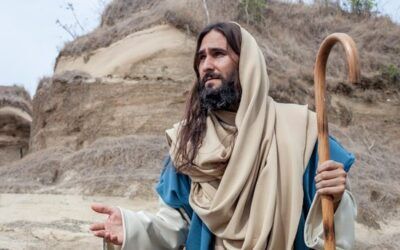You might know him as “Doubting Thomas” because he refused to believe in Jesus Christ’s resurrection without first seeing Jesus.
But Thomas was much more than this one label.
As one of the 12 disciples of Jesus, Thomas the Apostle followed Jesus and grew in His work of teaching, preaching, and healing. Despite his struggle with unbelief after Jesus was resurrected—the story that made Thomas famous—he went on to spread the Gospel throughout the known world.
The Bible doesn’t spend a lot of time talking about this unique character, but we’ll look at what it does say and what scholars have concluded from clues in history. You’ll learn:
Who Thomas was
Photo by Kevin Malik
In the New Testament, Thomas shows up in every single list of the 12 disciples (Matthew 10:3; Mark 3:18; Luke 6:15). But we know little else about him except for the accounts of him in the Gospel of John. These snippets of his interactions with Jesus and the other apostles show us a man of honesty, directness, and perhaps a little pessimism.
John 11:16 tells us that he was also called “Didymus,” which means “twin” in Greek (and the Aramaic for Thomas means the same). It’s possible that he had a twin brother, though we don’t know who that was.
Some suggest he was Jesus’ twin, but the Bible doesn’t offer any such evidence.1
And while some movies or TV shows depict him as having a wife or girlfriend, the Scriptures don’t say whether he was married or not.
His profession also is unknown. However, John 21:2-3 mentions that he went fishing with some of the apostles, so it’s possible he was also a fisherman.
Thomas’ life as a disciple
Like the other disciples, Jesus called Thomas during His ministry in Galilee. Thomas actively participated in that ministry of traveling, preaching, and healing.
After Jesus had mentored His disciples for some time, He even sent them out on their own, as Matthew 10:1 tells us:
“When [Jesus] had called His twelve disciples to Him, He gave them power over unclean spirits, to cast them out, and to heal all kinds of sickness and all kinds of disease” (NKJV).
Thomas was among those who were sent out (Matthew 10:3).
Little is said about what happened to Thomas during those mission trips, but the Gospel of John does record three interactions Thomas had with Jesus. More on those next.
His willingness to die for Jesus (John 11:16)
The first recorded interaction happened when Jesus received word of His friend Lazarus’s sickness. Lazarus was a close friend of His, and no doubt, the message from Lazarus’s sisters, Mary and Martha, came with the expectation that Jesus would come and heal him.
But that meant going back to Judea. The disciples protested:
“Rabbi, lately the Jews sought to stone You, and are You going there again?” (John 11:8, NKJV)
Why would Jesus go near Jerusalem, where religious leaders were plotting His death?
Jesus, though, recognized the importance of going to Lazarus (who had since died) and resurrecting him (John 11:14-15). This was part of His mission.
And that’s when Thomas pipes up:
“Let us also go, that we may die with Him” (John 11:16, NKJV).
His words are pessimistic, but they also show a deep commitment to following Jesus. Here’s how Adventist scholars put it:
“Since [Thomas’s] Master was bent on going to Bethany, his loyalty led him to follow, though to him, with his mind full of the darkest apprehension, it appeared that they were walking into the jaws of death.”2
He revealed courage—a willingness to step forward despite fear for his own life.
His question about the way to the Father (John 14:5-6)
Photo by Kaushik Panchal on Unsplash
The second interaction the Bible records happens soon after the Lord’s Supper. Jesus is with His disciples, seeking to comfort them before the crisis of His arrest and crucifixion.
Jesus gives them this beautiful promise:
“Let not your heart be troubled; you believe in God, believe also in Me. In My Father’s house are many mansions; if it were not so, I would have told you. I go to prepare a place for you. And if I go and prepare a place for you, I will come again and receive you to Myself; that where I am, there you may be also. And where I go you know, and the way you know” (John 14:1-4, NKJV).
And yet, Thomas is perplexed and asks:
“Lord, we do not know where You are going, and how can we know the way?” (John 14:5, NKJV)
His question showed that he still didn’t fully understand Jesus’ mission. Like many of the Jews, he incorrectly expected the Messiah to conquer the Romans and set up an earthly kingdom—the apostle Peter, too, had wrestled with this misconception (Matthew 16:22).
The Seventh-day Adventist Bible Commentary points out that the disciples “should have known [the answer to Thomas’s question], for they had been clearly told (see verse 4). It was hard for them to divest themselves of the tempting Jewish concept of the Messianic kingdom.”3
We can be thankful that Thomas asked the question, though.
It prompted one of the most well-known sayings of Jesus:
“Jesus said to him, ‘I am the way, the truth, and the life. No one comes to the Father except through Me’” (John 14:6, NKJV).
Thomas and his fellow apostles took a while to understand what this really meant, and their misconceptions would cause deep disappointment—so much so that Thomas would, in fact, not even believe the resurrection at first.
Let’s see how Jesus responded to him.
His disbelief of the resurrection of Jesus (John 20:24-29)
Photo by Lexi Laginess on Unsplash
The disappointment was over. Jesus had risen and appeared to all the disciples for the first time in the upper room!
All of them except Thomas (John 20:24).
He was not present at the time, whether out of discouragement or fear or some other reason. When he heard from the other disciples that they had seen Jesus, perhaps he felt a little spiteful that he’d been left out. We don’t know for sure.
His response, though, was adamant:
“Unless I see in His hands the print of the nails, and put my finger into the print of the nails, and put my hand into His side, I will not believe” (John 20:25, NKJV).
These strong words have earned him the name “Doubting Thomas,” though perhaps “Unbelieving Thomas” is more accurate. After all the disappointments of the past couple days, his sentiments are relatable. It was probably hard to muster faith in that moment.
It was nothing Jesus had said or done that caused Thomas’ doubt. From everything we know about Thomas, he had trusted in Jesus up until now. But he was still struggling to understand Jesus’ true purpose as the Messiah.
Jesus understood, though. Eight days later, He appeared to the disciples again—this time with Thomas present.
He approached Thomas directly:
“Reach your finger here, and look at My hands; and reach your hand here, and put it into My side. Do not be unbelieving, but believing” (John 20:27, NKJV).
Jesus made it clear that He knew the thoughts this apostle was struggling with, and that was enough for Thomas:
“There is no evidence that Thomas took advantage of the offer. The fact that the Lord read the doubts of his heart so accurately was to him convincing evidence of the resurrection.”4
Thomas’s next words were ones of faith:
“My Lord and my God!” (John 20:28)
In this verse, “my Lord” is a translation of the Hebrew “Yahweh,” which means that Thomas recognized Jesus as the same Jehovah God spoken of in the Old Testament.5
This faith would carry him forward in his mission as an apostle.
Thomas after the ascension
Thomas was present in the upper room when the 12 apostles—including Peter, James, John, Andrew, Judas (Thaddeus), and Philip—and other followers of Jesus prayed together and received the outpouring of the Holy Spirit (Acts 1:13). After that, the biblical account doesn’t say anything more about him. However, many believe he went as a missionary to Parthia (modern-day Iran) and India,6 where he was later martyred.
Christians in the state of Kerala in India believe that Thomas came there and first brought Christianity in AD 52.7
Adventist scholars mention something similar:
“In southern India there is a group of indigenous Christians who have been known for centuries as Thomas Christians. They have in their possession a version of the gospel story said to have been handed down to them by the apostle Thomas. They claim that Thomas suffered martyrdom on an eminence known as St. Thomas’ Mount, near Madras.”8
Church traditions also suggest that, during his later ministry, Thomas wrote books like the Gospel of Thomas and the Infancy Gospel of Thomas, though biblical scholars have many reasons to reject that he was the author.
For example, the Gospel of Thomas, which is supposedly a collection of 114 of Jesus’ sayings, is thought to have been written in the middle of the 2nd century—long after Thomas was alive. It also reflects the thinking of Greek mystics (Gnostics) because it connects salvation to knowing these secret sayings of Jesus.9 It isn’t consistent with the Bible.
As for Thomas’s death, we again don’t know for sure what happened, though it’s likely that he was martyred for his faith, as many of the other apostles were. Foxe’s Book of Martyrs gives this account:
“After converting many to Christ, he aroused the anger of the pagan priests, and was martyred being thrust through with a spear.”10
No longer unbelieving, Thomas chose to give his life completely for his risen Lord.
What Thomas’s life teaches us
Photo by Olivia Snow on Unsplash
Thomas, along with the other disciples, had a challenging call upon his life. To be a disciple of Jesus went against his preconceived ideas about the Messiah and brought him great disappointment. But Jesus saw the willingness in the heart of Thomas and patiently worked with his questioning and unbelief.
It encourages us that Jesus is working with us in our struggles, too.
Though we may struggle to believe or understand all Jesus has in store for us, He doesn’t turn away our questions or leave us in our unbelief. Rather, He helps strengthen our faith so that it becomes something deeper and more genuine.
God often reaches us through personal encounters, just as He did with Thomas after the resurrection. Thomas needed to know at that moment that Jesus knew his thoughts of unbelief, and the experience transformed him.
Though God may not appear to us visibly, this story encourages us to accept and trust what God has said regardless of whether it seems possible. And from the story of Thomas, we find a special blessing for us:
“Jesus said to him, ‘Thomas, because you have seen Me, you have believed. Blessed are those who have not seen and yet have believed’” (John 20:29, NKJV).
Those small seeds of belief will grow in our lives, just as they did in Thomas’s. Though you may feel like you’re struggling, take heart. Those struggles are part of the journey, and they will deepen your dedication to God. Just as they did with Thomas.
Related pages
- Nichols, Francis, ed., The Seventh-day Adventist Bible Commentary, vol. 5, p. 1013. [↵]
- Ibid. [↵]
- Ibid., p. 1035. [↵]
- Ibid., p. 1068. [↵]
- Ibid. [↵]
- Coogan, Michael, The Oxford Companion to the Bible, p. 743. [↵]
- Zacharia, Paul, “The Surprisingly Early History of Christianity in India,” Smithsonian Magazine. [↵]
- The Seventh-day Adventist Bible Commentary, vol. 5, p. 596. [↵]
- Wallace, J. Warner, “Why Shouldn’t We Trust the Non-Canonical Gospels Attributed to Thomas?” Cold-Case Christianity. [↵]
- Foxe, John, Foxe’s Book of Martyrs, p. 34. [↵]
More Answers
Is Jesus the Only Way to Heaven?
When the Bible says Jesus is the only way to heaven, what does it mean? This page explores key Bible passages for a clearer picture of God’s desire to save us.
The Protestant Roots of the Seventh-day Adventist Church
Learn how the Seventh-day Adventist Church finds its roots in the Protestant Reformation. And discover what makes the pursuit of truth so integral to Protestantism.
What Does the Bible Say About Heaven?
The afterlife is something on all of our minds. Whether Christian or not, human beings have a natural longing to understand what’s next. And nearly every religion has some kind of explanation for it.
Adventist Beliefs
Learn how the 28 Fundamental Beliefs summarize and describe Seventh-day Adventism. They are not a checklist of requirements; instead they show how Adventists interpret and apply Scripture.
Who is Jesus
Who Is Jesus, and Why Is He So Important to Us? Jesus Christ is the central figure of Christianity. Not only is He God’s Son and our Savior, He: Is who the Bible is all about Can give us eternal life Is part of the Trinity with God the Father and the Holy Spirit Is...
Do Seventh-Day Adventists Have “Rules” For Clothing?
Many religions have guidelines on dress, but what about the Adventist Church? Discover how Adventists choose to dress based on biblical principles.
Relationships
The relationships of our lives can range from blissful to rocky, easy to difficult, fun to boring…
Prayer
Prayer is a simple act of faith with powerful life-changing effects. It’s talking to God and opening your heart to Him, just like you would open your heart to a friend.
What the Bible Says About Money
From stewardship to acts of investment and generosity, let’s explore what the Bible says about having a healthy relationship with our money.
Death
Have you ever wondered about life after death, or what some refer to as the afterlife?
History of the Adventist Church
After Jesus didn’t return in 1844 as many Millerites had expected, a small group rediscovered Bible truths that led them to start the Seventh-day Adventist Church in 1863. Here’s their story.
What Does God Look Like According to the Bible?
What Does God Look Like According to the Bible?As human beings, it’s natural for us to wonder about God’s appearance. But the Bible says very little about it. It’s not hard to understand why, though. As the Creator of the entire universe, His existence transcends our...
The Parables of Jesus
Have you ever been on the verge of sleep in the middle of a long lecture or sermon when suddenly the speaker takes a turn and begins to tell a story?
Jesus and John the Baptist: Their Relationship and Ministry
John the Baptist and Jesus were cousins, friends, and close coworkers in ministry. Learn the lasting significance of their relationship.
Sin
While this might seem like a complicated question, there’s a simple way to look at it. Sin is a failure to love God and love others. It is the opposite of love.
Why Did Jesus Have Disciples and Who Were They?
During Jesus’ ministry on earth, He selected certain individuals to help with and continue His work. They would be referred to during that time as His “disciples.”
How to Really Read and Understand the Bible
If you’re new to the Bible or haven’t picked it up in a while, how do you start? Find out 6 basic steps to read the Bible, plus some helpful reading plans to try.
Does Jesus Appear in the Old Testament?
Before His incarnation, Jesus also played an active role in the redemption and salvation of humanity. Discover the different ways He appeared in Old Testament stories.
How Does Forgiveness Really Work? What Does the Bible Say?
Forgiveness—a familiar word but often-misunderstood concept. Learn how the Bible defines it, how it’s supposed to work, and what it shows us about God.
Jesus’ Baptism: What It Means and Why It Matters
Jesus’s baptism marked the beginning of His earthly ministry. It was God’s big reveal regarding who Jesus is.
11 Reasons People Become Seventh-day Adventists
Curious why many people become Adventists? Here are elements of Adventist beliefs, values, and mission often reflected in people’s decisions to join.
Why Is the Genealogy of Jesus Christ So Important?
Have you ever traced your genealogy back several generations? Did you ever try to find out if your ancestors did anything famous (or infamous)?
Jesus and the Woman at the Well: Breaking Down Barriers
Jesus’ meeting with the woman at the well reveals His heart for hurting people and His desire to break down prejudice. This page looks at how Jesus reached out to her.
The New Covenant—What It Is and What It Means for Us Today
The Bible talks about the covenant, or promise, God made to save us from sin. Learn more about the old and new covenants and why they matter to us.
Who is The Son of Man in the Bible?
In calling Himself the Son of Man, Jesus confirmed His role as humanity’s savior. Learn what else this title tells us about Jesus.
What’s the Seventh-day Adventist General Conference Session?
At the General Conference Session, Adventist delegates from around the world gather to assess the state of the organization, pray, and discuss current issues. Here’s how it works.
Who Was Mary, the Mother of Jesus Christ?
Mary, Jesus’ mother, was a humble woman, deeply committed to following God’s will for her life. Learn what the Bible says about Mary and what we can learn from her.
Didn’t find your answer? Ask us!
We understand your concern of having questions but not knowing who to ask—we’ve felt it ourselves. When you’re ready to learn more about Adventists, send us a question! We know a thing or two about Adventists.




























